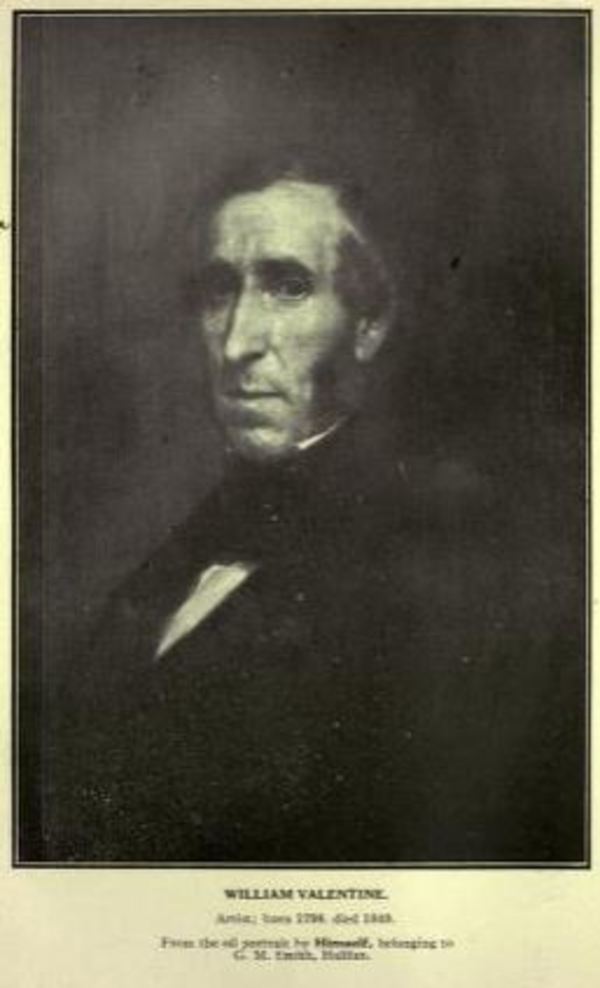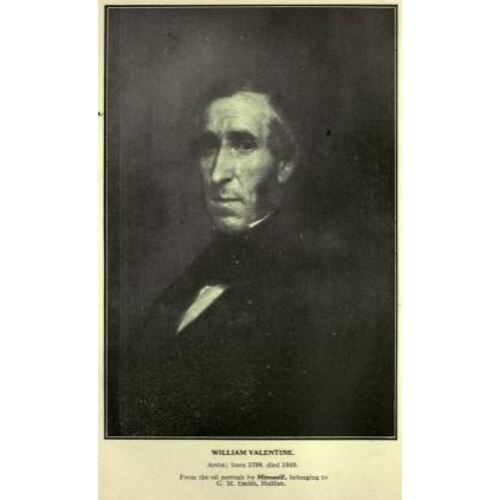
Source: Link
VALENTINE, WILLIAM, painter, glazier, and daguerreotypist; b. 1798 in Whitehaven, England; m. 2 June 1822 Susannah Elizabeth Smith in Halifax, and they had two daughters; m. secondly 12 Dec. 1830 Sarah Ann Sellon in Halifax; d. there 26 Dec. 1849.
Nothing is known about William Valentine before he immigrated to Halifax in 1818. It has been suggested that he was a relative and pupil of Robert Field*, the most important painter in Nova Scotia at the beginning of the 19th century, but they apparently were never in the same place at the same time, and Joseph Howe*, who knew Valentine well, asserted that he was self-taught. On 23 Jan. 1819 Valentine first advertised himself as a teacher of drawing and on 6 March as a portrait and landscape painter. The “very liberal encouragement” he was experiencing evidently dwindled, perhaps because of the post-war economic depression in the province, and by August 1820 he had gone into partnership with his cousin James Bell in a “ship, sign, house and ornamental painting and glass firm.” Valentine carried on as a painter and glazier on Stairs’ Wharf after the partnership was dissolved in May 1824, and three years later he advertised his removal to a new shop just off Barrington Street.
Valentine’s earliest paintings yet identified date from 1827. His main interest was in portraits, but he occasionally depicted historical subjects, such as King John signing Magna Charta, done about 1830 and now in the Nova Scotia College of Art and Design. He also ventured into classical themes, but these paintings have been lost. In December 1831 Valentine was an original member of the managing committee of the Halifax Mechanics’ Institute, in which he retained a lifelong interest. The following year he presented to the institute a portrait of its first president, Dr William Grigor*, and he also finished a portrait of John Howe* for Howe’s son Joseph. Despite his growing stature as an artist, Valentine had to leave Halifax to secure commissions. In August 1833 he advertised in the Charlottetown Royal Gazette as a portrait painter and miniaturist, and the next year he was in St John’s in search of work. He seems to have had to revert to house painting when business was slack.
About 1836 Valentine travelled to England, where he studied the well-known painters of the day such as Sir Thomas Lawrence and made copies of their works. The experience had a noticeable effect on his painting, which improved markedly in tone and colour; and from the time he returned about March 1837 until 1844 he enjoyed his best success. His portraits from this period include those of Samuel George William Archibald, Thomas Chandler Haliburton*, Brenton Halliburton*, John Young and his son William*, Peter Nordbeck*, John Sparrow Thompson*, Alexander Keith*, and well over 100 other eminent Nova Scotians and their wives. Valentine obtained the best of the local patronage, receiving virtually all his commissions from leading merchants and professionals.
In 1839 Valentine again travelled to Europe. That year the photographic process of Louis-Jacques-Mandé Daguerre was made public in France. Valentine reportedly claimed to have received instruction in daguerreotyping “at the very fountain-head in Paris,” and it is possible he studied with Daguerre himself. The process evidently represented to Valentine a way of producing the cheap yet accurate portraits his clients demanded and a source of supplementary income. His earliest advertisement for daguerreotyping appeared in the Saint John Morning News on 15 Nov. 1841, and on 1 Jan. 1842 he announced in the Halifax Times that he was “prepared to execute Daguerreotype likenesses in a beautiful style” with the aid of a “first-rate apparatus” from the United States. Valentine also made visits to Charlottetown and St John’s advertising the service. However, neither painting nor photography proved remunerative enough, and as late as 1848 he found it necessary to work as a house and sign painter.
Valentine’s last known work is a portrait of Andrew MacKinlay*, president of the Mechanics’ Institute, which was presented to that institution in October 1849. A few years before his death a fire in his studio destroyed many of his pictures and damaged his photographic apparatus, and this disaster is said to have hastened his end. It is not known how many portraits Valentine executed – the historian Harry Piers estimated between 125 and 150 – and there has never been a comprehensive exhibition of his work. However, after Field he was the most important portrait painter in early 19th-century Nova Scotia. An obituary in the Novascotian was written by Joseph Howe, who also composed a eulogy. Valentine is buried in Camp Hill Cemetery near his friend Peter Nordbeck.
Examples of William Valentine’s work may be seen at the town hall in Liverpool, N.S., and in Halifax at the Atlantic School of Theology, the Law Courts of N.S., the N.S. College of Art and Design, the N.S. Museum, and the PANS. His oil self-portrait is in the PANS and has been reproduced (facing p.130) in the article by Harry Piers cited below.
Camp Hill Cemetery (Halifax), Gravestone inscription. PANS, RG 1, 448. Private arch., D. C. Mackay estate (Halifax), Harry Piers, two letters to L. A. Bowser concerning Valentine’s painting King John signing Magna Charta, 30 Sept. 1929. Catalogue of Mr. Eagar’s exhibition of paintings (Halifax, 1838). Acadian Recorder, 28 Jan. 1819. Free Press (Halifax), 8 Aug. 1820. Royal Gazette (Charlottetown), 6 Aug. 1833. Times (Halifax), 1 Jan. 1842. Harper, Early painters and engravers. National Gallery of Canada, Catalogue of paintings and sculpture, ed. R. H. Hubbard (3v., Ottawa and Toronto, 1957–60), 3. William Colgate, Canadian art, its origins & development (Toronto, 1943). Harper, Painting in Canada (1966). D. [C.] Mackay, “Artists and their pictures,” Canadian Antiques Collector (Toronto), 7 (1972), no. l: 81–86. Harry Piers, “Artists in Nova Scotia,” N.S. Hist. Soc., Coll., 18 (1914): 101–65.
Cite This Article
D. C. Mackay, “VALENTINE, WILLIAM,” in Dictionary of Canadian Biography, vol. 7, University of Toronto/Université Laval, 2003–, accessed March 28, 2025, https://www.biographi.ca/en/bio/valentine_william_7E.html.
The citation above shows the format for footnotes and endnotes according to the Chicago manual of style (16th edition). Information to be used in other citation formats:
| Permalink: | https://www.biographi.ca/en/bio/valentine_william_7E.html |
| Author of Article: | D. C. Mackay |
| Title of Article: | VALENTINE, WILLIAM |
| Publication Name: | Dictionary of Canadian Biography, vol. 7 |
| Publisher: | University of Toronto/Université Laval |
| Year of revision: | 1988 |
| Access Date: | March 28, 2025 |



